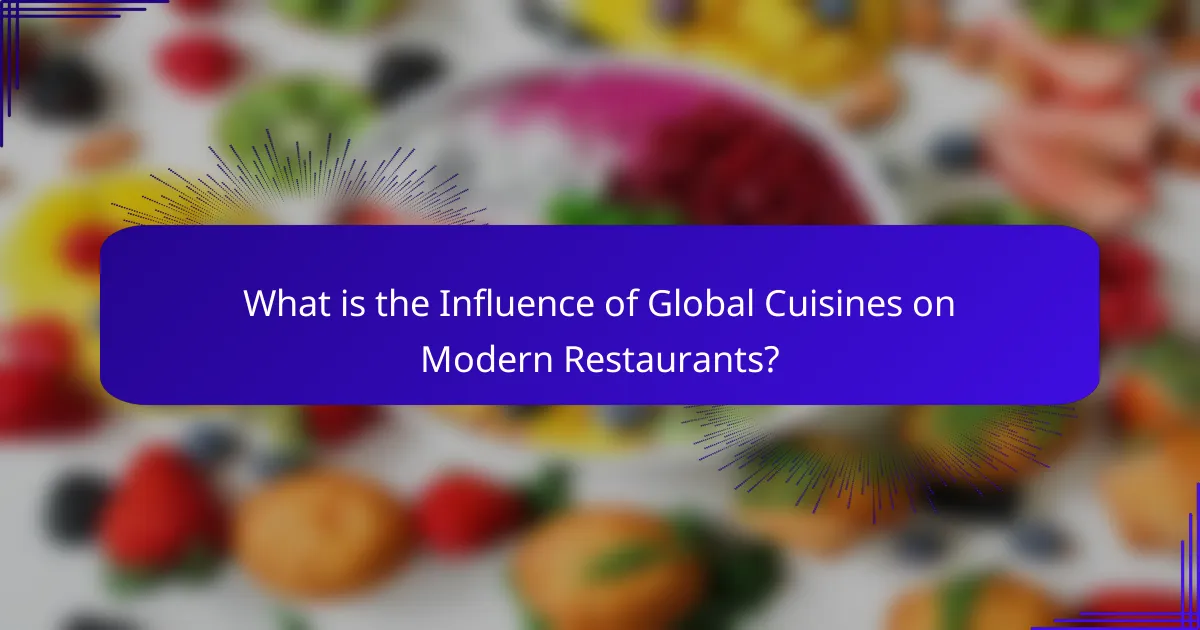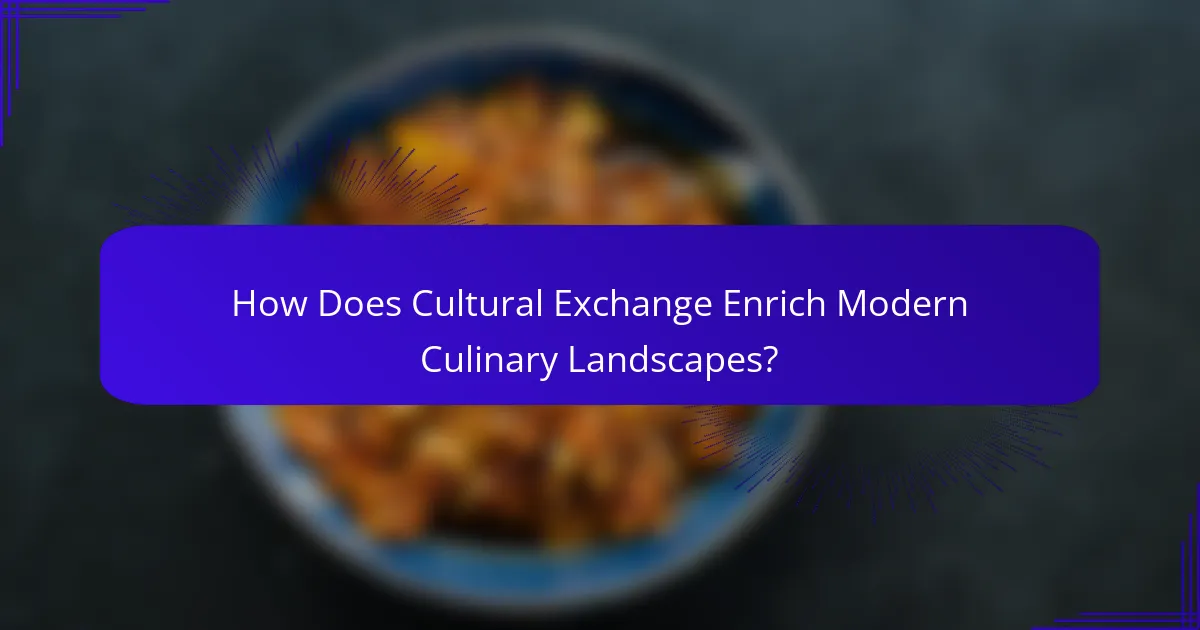
What is the Influence of Global Cuisines on Modern Restaurants?
Global cuisines significantly influence modern restaurants by shaping menu offerings and dining experiences. Restaurants now incorporate diverse flavors and techniques from around the world. This trend reflects a growing consumer interest in culinary exploration. For example, fusion dishes blend elements from different cuisines, like Korean tacos or sushi burritos. Additionally, global cuisines facilitate cultural exchange and understanding through food. Surveys indicate that 60% of diners prefer restaurants that offer international dishes. This demand encourages chefs to innovate and experiment with traditional recipes. Overall, the influence of global cuisines enhances creativity and variety in modern dining.
How do global cuisines shape contemporary dining experiences?
Global cuisines significantly shape contemporary dining experiences by introducing diverse flavors and cooking techniques. This variety enhances menu offerings in restaurants worldwide. Diners now seek authentic experiences that reflect global culinary traditions. Fusion dishes combine elements from multiple cuisines, creating innovative meals. Cultural exchange through food fosters appreciation for different heritages. Statistics show that 78% of consumers enjoy trying international dishes. Additionally, social media influences dining choices, highlighting global trends. Overall, global cuisines enrich the dining landscape, making it more inclusive and dynamic.
What are the historical interactions that led to this influence?
The historical interactions that led to the influence of global cuisines on modern restaurants include trade, colonization, and migration. Trade routes, such as the Silk Road, facilitated the exchange of spices and culinary techniques. The Age of Exploration in the 15th and 16th centuries expanded European access to new ingredients from Asia and the Americas. Colonization introduced indigenous foods to European diets, blending culinary practices. Migration patterns, particularly in the 20th century, brought diverse populations and their cuisines to urban centers. These interactions fostered cultural exchange and the birth of fusion dishes. For example, the introduction of tomatoes from the Americas transformed Italian cuisine. Thus, historical interactions have significantly shaped modern culinary landscapes.
How do cultural preferences impact menu design in modern restaurants?
Cultural preferences significantly impact menu design in modern restaurants. Restaurants often tailor their menus to reflect the tastes and traditions of their target demographics. For example, a restaurant in a multicultural city may offer diverse dishes to cater to various cultural backgrounds. This approach attracts a wider customer base and enhances dining experiences.
Research shows that menu items reflecting local flavors can increase customer satisfaction. A study by the Cornell University Food and Brand Lab found that culturally relevant dishes can lead to higher sales. Additionally, restaurants may incorporate traditional cooking methods to honor cultural practices. This not only preserves authenticity but also appeals to customers seeking genuine experiences.
In summary, cultural preferences shape menu design by influencing dish selection, presentation, and preparation methods, ultimately affecting customer engagement and business success.
Why is cultural exchange important in the context of global cuisines?
Cultural exchange is important in the context of global cuisines because it fosters diversity and innovation. This exchange allows different culinary traditions to influence one another. As a result, unique fusion dishes emerge, blending flavors and techniques. Historical trade routes facilitated the sharing of ingredients and cooking methods. For example, the introduction of spices from Asia transformed European cooking. Cultural exchange also promotes understanding and appreciation of different cultures. This leads to a more inclusive dining experience. Restaurants often reflect this diversity by offering international menus. Increased access to global cuisines enhances culinary creativity and consumer choice.
What role does cultural exchange play in culinary innovation?
Cultural exchange is a catalyst for culinary innovation. It allows diverse culinary traditions to merge and evolve. This interaction introduces new ingredients and techniques to various cuisines. For example, the introduction of spices from Asia transformed European cooking in the Middle Ages. Similarly, the blending of Mexican and Japanese cuisines has led to unique dishes like sushi burritos. Cultural exchange also fosters creativity among chefs, encouraging them to experiment with flavors. This results in the development of fusion cuisine, which is increasingly popular in modern restaurants. Studies show that restaurants offering fusion dishes often attract a broader clientele. Thus, cultural exchange significantly enriches the culinary landscape by promoting innovation and diversity.
How do chefs incorporate elements from various cultures into their dishes?
Chefs incorporate elements from various cultures into their dishes by blending traditional ingredients and techniques. They often use spices and cooking methods unique to different cuisines. For example, a chef may combine Italian pasta with Thai curry flavors. This fusion creates innovative dishes that reflect cultural exchange. Chefs also draw inspiration from global food trends. They may adapt recipes to include local ingredients while maintaining cultural authenticity. This practice enhances the dining experience and promotes diversity in cuisine. Studies show that cultural fusion in food increases customer interest and satisfaction.

What are the Key Trends in Global Cuisines Affecting Modern Restaurants?
Key trends in global cuisines affecting modern restaurants include fusion cuisine, plant-based diets, and sustainability. Fusion cuisine combines elements from different culinary traditions, creating innovative dishes. The rise of plant-based diets reflects a growing consumer preference for healthier, environmentally friendly options. Sustainability practices, such as sourcing local ingredients, are increasingly prioritized by restaurants. Additionally, ethnic cuisines are gaining popularity, influencing menus worldwide. The global exchange of culinary techniques and flavors is reshaping dining experiences. Statistics show that 39% of consumers are interested in trying international dishes. This trend is evident in the increasing number of restaurants offering diverse global menus.
How are health-conscious trends influencing global cuisine offerings?
Health-conscious trends are significantly influencing global cuisine offerings by prioritizing nutritious ingredients and mindful eating. Many restaurants are now incorporating plant-based options to cater to the growing demand for vegetarian and vegan diets. This shift is evident as global cuisines adapt traditional recipes to include healthier alternatives, such as whole grains and fresh vegetables.
Moreover, international culinary practices are increasingly focusing on reducing sugar and unhealthy fats. Research shows that consumers are more aware of nutritional labels and ingredient sourcing. Consequently, chefs are experimenting with superfoods and organic produce to attract health-conscious diners.
In addition, the rise of food-related social media platforms has amplified the visibility of health-oriented dishes. This trend encourages restaurants to present visually appealing, nutritious meals that resonate with health-savvy consumers. Overall, the influence of health-conscious trends is reshaping menus worldwide, promoting a culture of wellness in dining experiences.
What specific dietary preferences are being catered to in modern menus?
Modern menus cater to various dietary preferences including vegetarian, vegan, gluten-free, and paleo options. These preferences reflect a growing awareness of health, sustainability, and ethical eating. Vegetarian dishes exclude meat and focus on plant-based ingredients. Vegan options eliminate all animal products, appealing to those prioritizing animal welfare or specific health benefits. Gluten-free choices accommodate individuals with celiac disease or gluten sensitivity. The paleo diet emphasizes whole foods and excludes processed items, attracting health-conscious diners. Research indicates that 39% of consumers actively seek out plant-based options, highlighting the demand for diverse dietary preferences in restaurant menus.
How do sustainability practices affect ingredient sourcing for global dishes?
Sustainability practices significantly influence ingredient sourcing for global dishes. These practices prioritize environmentally friendly methods, impacting the availability and selection of ingredients. Sourcing locally reduces carbon footprints and supports local economies. Sustainable farming methods enhance soil health and biodiversity, resulting in higher-quality produce. Certifications like organic or fair trade guide consumers toward responsible choices. Research indicates that 66% of consumers prefer sustainable ingredients. This demand shapes restaurant menus and influences global culinary trends. Chefs increasingly seek partnerships with sustainable suppliers to align with consumer values.
What technology trends are shaping the way global cuisines are served?
Technology trends shaping global cuisines include the rise of online food delivery platforms. These platforms enable diverse cuisines to reach wider audiences quickly. Mobile apps facilitate easy access to menus and ordering. Virtual kitchens allow chefs to experiment with global dishes without traditional restaurant constraints. Additionally, social media influences dining choices and promotes culinary trends. Data analytics helps restaurants tailor offerings based on customer preferences. Finally, automation in food preparation improves efficiency and consistency in serving global dishes.
How does social media impact the popularity of certain cuisines?
Social media significantly impacts the popularity of certain cuisines. Platforms like Instagram and TikTok showcase visually appealing dishes. This exposure leads to increased interest and demand for these cuisines. For instance, a 2021 study by the Food Marketing Institute found that food posts on social media can boost restaurant visits by up to 30%. Additionally, trending hashtags can create viral food challenges, further promoting specific cuisines. Influencers often collaborate with restaurants to feature unique dishes, enhancing visibility. As a result, social media acts as a powerful marketing tool for diverse culinary experiences.
What role does online food delivery play in the fusion of cuisines?
Online food delivery facilitates the fusion of cuisines by providing access to diverse culinary options. It allows consumers to explore and order dishes from various cultural backgrounds. This accessibility encourages experimentation with flavors and ingredients. Online platforms often feature fusion dishes that blend elements from different cuisines. For instance, a popular offering might be sushi burritos, combining Japanese and Mexican influences. The convenience of delivery promotes the popularity of these innovative dishes. Additionally, food delivery services often highlight trending fusion concepts, driving consumer interest. This trend reflects a growing multicultural palate among diners. Overall, online food delivery plays a significant role in shaping the landscape of fusion cuisine.

What are Fusion Dishes and How Do They Represent Cultural Exchange?
Fusion dishes are culinary creations that combine elements from different culinary traditions. They often blend ingredients, techniques, and flavors from diverse cultures. This hybridization reflects the interconnectedness of global cuisines. It showcases how cultural exchange influences food preparation and presentation. For instance, sushi burritos merge Japanese sushi with Mexican burrito concepts. Such dishes highlight the adaptability of culinary practices. Additionally, fusion dishes foster appreciation for diverse cultures. They encourage diners to explore new flavors and traditions. Thus, fusion cuisine serves as a bridge between cultures, promoting understanding and acceptance.
What defines a fusion dish in the context of global cuisines?
A fusion dish is defined as a culinary creation that combines elements from different global cuisines. These dishes often blend ingredients, cooking techniques, and flavor profiles from diverse cultural backgrounds. For example, a sushi burrito merges Japanese sushi with Mexican burrito concepts. The combination creates a unique dining experience that reflects cultural exchange. Fusion dishes can also highlight the growing trend of globalization in the culinary world. This trend encourages chefs to experiment with flavors and techniques from various traditions. As a result, fusion cuisine has gained popularity in modern restaurants.
How do chefs creatively blend flavors from different cultures?
Chefs creatively blend flavors from different cultures by incorporating diverse ingredients and cooking techniques. They often study traditional recipes from various cuisines. This knowledge allows them to understand flavor profiles and ingredient compatibility. Chefs experiment by combining spices, herbs, and cooking methods. For example, they might use Thai spices in a classic Italian pasta dish. This approach creates unique fusion dishes that appeal to a broad audience. Research shows that cultural exchange enhances culinary innovation. Chefs also attend workshops and collaborate with peers from different backgrounds. This collaboration fosters creativity and introduces new perspectives on flavor combinations.
What are some popular examples of successful fusion dishes?
Some popular examples of successful fusion dishes include sushi burritos, Korean tacos, and butter chicken pizza. Sushi burritos combine sushi ingredients in a burrito format. This dish reflects the growing trend of portable meals. Korean tacos blend Korean barbecue flavors with traditional Mexican taco elements. They often feature marinated meats and fresh toppings. Butter chicken pizza merges Indian butter chicken with Italian pizza. This fusion showcases the appeal of cross-cultural flavors. Other notable examples include banh mi burgers and poke bowls. These dishes illustrate the creativity and diversity found in modern culinary practices.
Why do fusion dishes appeal to modern diners?
Fusion dishes appeal to modern diners due to their innovative combination of diverse culinary traditions. These dishes offer unique flavors that excite the palate. They also reflect the growing globalization of food culture. Diners are increasingly seeking new experiences and adventurous tastes. Fusion cuisine allows for creativity and personalization in meal choices. The rise of social media amplifies the appeal of visually stunning dishes. Additionally, fusion dishes often cater to dietary preferences and restrictions. This adaptability makes them attractive to a broader audience.
How do fusion dishes enhance the dining experience?
Fusion dishes enhance the dining experience by combining diverse culinary traditions. This blend creates unique flavors and textures that excite the palate. Diners enjoy the novelty of tasting familiar ingredients in unfamiliar ways. Fusion cuisine often showcases creativity and innovation in food preparation. It encourages cultural exchange by introducing diners to global flavors. Research indicates that 70% of consumers are more likely to try fusion dishes. This trend reflects a growing appetite for culinary exploration. Overall, fusion dishes transform meals into memorable experiences.
What challenges do restaurants face when creating fusion cuisine?
Restaurants face several challenges when creating fusion cuisine. One major challenge is balancing flavors from different culinary traditions. This requires a deep understanding of each cuisine’s ingredients and techniques. Another challenge is maintaining authenticity while innovating. Diners often expect genuine representations of cultural dishes. Additionally, sourcing authentic ingredients can be difficult. Some specialty items may not be readily available in certain regions.
Moreover, fusion cuisine can confuse customers. Patrons may have preconceived notions about traditional dishes. This can lead to mixed reviews if expectations are not met. Training staff to understand and execute fusion concepts is also essential. Staff must be knowledgeable about diverse cuisines to ensure quality. Lastly, pricing can be a challenge. High-quality ingredients and skilled preparation may drive up costs, impacting profitability.

How Does Cultural Exchange Enrich Modern Culinary Landscapes?
Cultural exchange enriches modern culinary landscapes by introducing diverse flavors and cooking techniques. This blending of culinary traditions fosters innovation in recipe development. For example, fusion cuisine combines elements from different cultures, such as Korean tacos or sushi burritos. Such dishes reflect the influence of globalization on food trends. Restaurants increasingly feature international ingredients, enhancing menu variety. According to the National Restaurant Association, 60% of chefs report incorporating global flavors into their menus. Additionally, cultural exchange promotes understanding and appreciation of different culinary heritages. This dynamic interaction contributes to the evolution of food culture worldwide.
What are the benefits of embracing diverse culinary traditions?
Embracing diverse culinary traditions enhances cultural appreciation and promotes inclusivity. It allows individuals to experience flavors and techniques from various regions. This exposure enriches personal cooking skills and creativity. Diverse cuisines often incorporate unique ingredients with health benefits. For example, Mediterranean diets are linked to lower heart disease rates. Culinary diversity can also boost local economies through tourism and restaurant growth. Furthermore, it fosters social connections among people from different backgrounds. Studies show that shared meals can strengthen community bonds.
How does cultural exchange promote understanding and appreciation of food?
Cultural exchange promotes understanding and appreciation of food by facilitating the sharing of culinary traditions. When individuals from different cultures share their food practices, it fosters curiosity and respect for diverse cuisines. This exchange allows people to experience new flavors and cooking techniques. According to a study by the University of California, cultural interactions increase culinary awareness and openness. Such experiences can lead to a greater appreciation of the historical and social contexts of various dishes. Exposure to different foods can also inspire innovation in cooking, leading to fusion cuisines. This blending of culinary elements creates unique dining experiences that reflect a global palate. Overall, cultural exchange enriches the understanding of food as a vital component of cultural identity.
What impact does cultural diversity have on restaurant success?
Cultural diversity positively impacts restaurant success by enhancing menu variety and attracting a broader customer base. Diverse culinary influences allow restaurants to offer unique dishes that appeal to various tastes. This variety can differentiate a restaurant in a competitive market. Additionally, restaurants that embrace cultural diversity often create inclusive environments, fostering customer loyalty. According to a study by the National Restaurant Association, 70% of consumers are more likely to visit restaurants that offer diverse menus. This preference highlights the importance of cultural representation in attracting diverse clientele. Ultimately, cultural diversity contributes to increased innovation and adaptability in the restaurant industry.
What practical tips can restaurants use to effectively incorporate global cuisines?
Restaurants can effectively incorporate global cuisines by researching authentic recipes. Understanding the cultural significance of dishes enhances menu development. Training staff in preparation techniques ensures quality. Sourcing ingredients from reputable suppliers maintains authenticity. Collaborating with chefs from different culinary backgrounds fosters creativity. Offering tasting events introduces customers to new flavors. Adapting dishes to local tastes can increase acceptance. Engaging with the community through cultural events promotes awareness and appreciation.
How can chefs stay updated on global culinary trends?
Chefs can stay updated on global culinary trends by actively engaging with culinary publications and attending industry events. Subscribing to reputable culinary magazines provides insights into emerging trends. Participating in food festivals allows chefs to experience diverse cuisines firsthand. Networking with other chefs fosters the exchange of innovative ideas. Online platforms and social media are valuable resources for discovering new techniques and ingredients. Following influential chefs and food bloggers keeps chefs informed about popular trends. Continuous education through workshops and culinary courses enhances their skills and knowledge. Research shows that chefs who engage with these resources are better equipped to adapt to changing culinary landscapes.
What strategies can restaurants employ to create authentic fusion dishes?
Restaurants can create authentic fusion dishes by combining ingredients and techniques from different culinary traditions. First, they should research and understand the cultural significance of each cuisine. This knowledge helps in selecting compatible flavors and cooking methods. Next, chefs can experiment with ingredient pairings that respect both cultures. For example, using traditional spices from one cuisine with staple ingredients from another can yield unique results. Additionally, restaurants should engage with community members from the cultures represented in their dishes. This collaboration can provide insights and authenticity. Finally, taste testing with diverse groups can refine the dishes and ensure they resonate well with customers. These strategies promote creativity while honoring the origins of each cuisine.
The main entity of the article is the influence of global cuisines on modern restaurants. The article explores how diverse culinary traditions shape menu offerings, dining experiences, and cultural exchange, highlighting key trends such as fusion cuisine, plant-based diets, and sustainability practices. It examines the historical interactions that have led to this influence, the impact of cultural preferences on menu design, and the role of technology and social media in promoting global cuisines. Additionally, the article discusses the benefits of embracing culinary diversity and provides practical tips for restaurants to effectively incorporate global flavors and create authentic fusion dishes.
